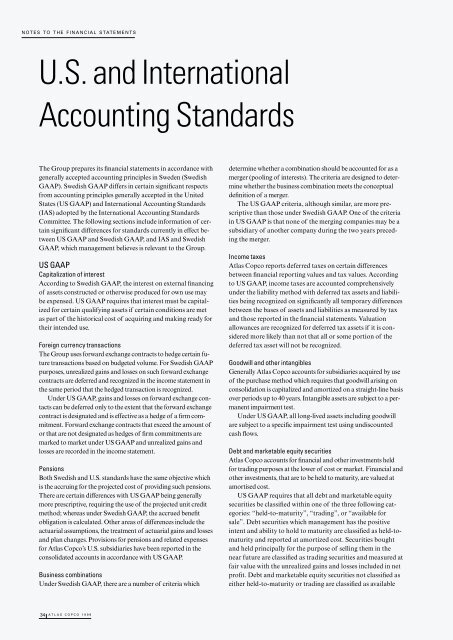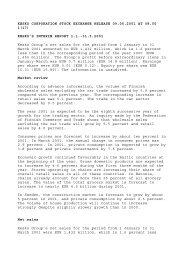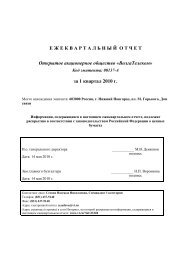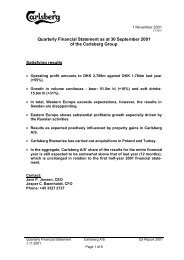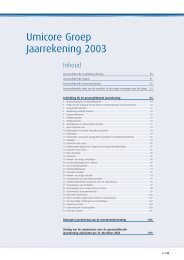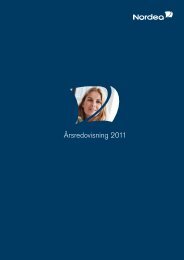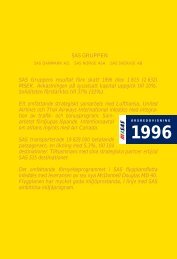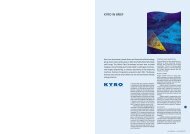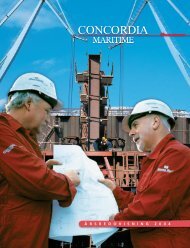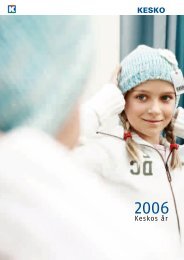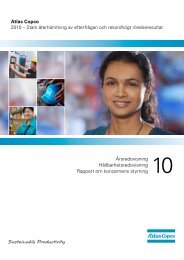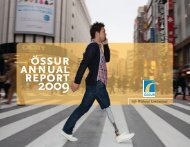Atlas Copco - Annual Report 1999
Atlas Copco - Annual Report 1999
Atlas Copco - Annual Report 1999
You also want an ePaper? Increase the reach of your titles
YUMPU automatically turns print PDFs into web optimized ePapers that Google loves.
NOTES TO THE FINANCIAL STATEMENTS<br />
U.S. and International<br />
Accounting Standards<br />
The Group prepares its financial statements in accordance with<br />
generally accepted accounting principles in Sweden (Swedish<br />
GAAP). Swedish GAAP differs in certain significant respects<br />
from accounting principles generally accepted in the United<br />
States (US GAAP) and International Accounting Standards<br />
(IAS) adopted by the International Accounting Standards<br />
Committee. The following sections include information of certain<br />
significant differences for standards currently in effect between<br />
US GAAP and Swedish GAAP, and IAS and Swedish<br />
GAAP, which management believes is relevant to the Group.<br />
US GAAP<br />
Capitalization of interest<br />
According to Swedish GAAP, the interest on external financing<br />
of assets constructed or otherwise produced for own use may<br />
be expensed. US GAAP requires that interest must be capitalized<br />
for certain qualifying assets if certain conditions are met<br />
as part of the historical cost of acquiring and making ready for<br />
their intended use.<br />
Foreign currency transactions<br />
The Group uses forward exchange contracts to hedge certain future<br />
transactions based on budgeted volume. For Swedish GAAP<br />
purposes, unrealized gains and losses on such forward exchange<br />
contracts are deferred and recognized in the income statement in<br />
the same period that the hedged transaction is recognized.<br />
Under US GAAP, gains and losses on forward exchange contacts<br />
can be deferred only to the extent that the forward exchange<br />
contract is designated and is effective as a hedge of a firm commitment.<br />
Forward exchange contracts that exceed the amount of<br />
or that are not designated as hedges of firm commitments are<br />
marked to market under US GAAP and unrealized gains and<br />
losses are recorded in the income statement.<br />
Pensions<br />
Both Swedish and U.S. standards have the same objective which<br />
is the accruing for the projected cost of providing such pensions.<br />
There are certain differences with US GAAP being generally<br />
more prescriptive, requiring the use of the projected unit credit<br />
method; whereas under Swedish GAAP, the accrued benefit<br />
obligation is calculated. Other areas of differences include the<br />
actuarial assumptions, the treatment of actuarial gains and losses<br />
and plan changes. Provisions for pensions and related expenses<br />
for <strong>Atlas</strong> <strong>Copco</strong>’s U.S. subsidiaries have been reported in the<br />
consolidated accounts in accordance with US GAAP.<br />
Business combinations<br />
Under Swedish GAAP, there are a number of criteria which<br />
34 ATLAS COPCO <strong>1999</strong><br />
determine whether a combination should be accounted for as a<br />
merger (pooling of interests). The criteria are designed to determine<br />
whether the business combination meets the conceptual<br />
definition of a merger.<br />
The US GAAP criteria, although similar, are more prescriptive<br />
than those under Swedish GAAP. One of the criteria<br />
in US GAAP is that none of the merging companies may be a<br />
subsidiary of another company during the two years preceding<br />
the merger.<br />
Income taxes<br />
<strong>Atlas</strong> <strong>Copco</strong> reports deferred taxes on certain differences<br />
between financial reporting values and tax values. According<br />
to US GAAP, income taxes are accounted comprehensively<br />
under the liability method with deferred tax assets and liabilities<br />
being recognized on significantly all temporary differences<br />
between the bases of assets and liabilities as measured by tax<br />
and those reported in the financial statements. Valuation<br />
allowances are recognized for deferred tax assets if it is considered<br />
more likely than not that all or some portion of the<br />
deferred tax asset will not be recognized.<br />
Goodwill and other intangibles<br />
Generally <strong>Atlas</strong> <strong>Copco</strong> accounts for subsidiaries acquired by use<br />
of the purchase method which requires that goodwill arising on<br />
consolidation is capitalized and amortized on a straight-line basis<br />
over periods up to 40 years. Intangible assets are subject to a permanent<br />
impairment test.<br />
Under US GAAP, all long-lived assets including goodwill<br />
are subject to a specific impairment test using undiscounted<br />
cash flows.<br />
Debt and marketable equity securities<br />
<strong>Atlas</strong> <strong>Copco</strong> accounts for financial and other investments held<br />
for trading purposes at the lower of cost or market. Financial and<br />
other investments, that are to be held to maturity, are valued at<br />
amortised cost.<br />
US GAAP requires that all debt and marketable equity<br />
securities be classified within one of the three following categories:<br />
“held-to-maturity”, “trading”, or “available for<br />
sale”. Debt securities which management has the positive<br />
intent and ability to hold to maturity are classified as held-tomaturity<br />
and reported at amortized cost. Securities bought<br />
and held principally for the purpose of selling them in the<br />
near future are classified as trading securities and measured at<br />
fair value with the unrealized gains and losses included in net<br />
profit. Debt and marketable equity securities not classified as<br />
either held-to-maturity or trading are classified as available


